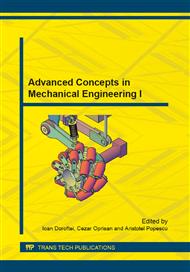p.606
p.612
p.618
p.626
p.632
p.638
p.644
p.648
p.654
Virtual Planning of Robot Trajectories for Spray Painting Applications
Abstract:
In this paper is presented a Virtual Reality application that can be used for automatic generation of robot trajectories for spray painting operations conducted on products with complex surfaces. The trajectory generation for robots that perform painting operations of complex curved surfaces was achieved by implementing a generic algorithm capable of maintaining an optimal distance for painting. The distance between the effecter of the robot and the surface of the CAD model, used to compensate and maintain an optimal painting distance, is determined by a "rayhit" collision detection algorithm that allows the detection of the contact between a linear segment and the mesh of the virtual object. To visualize in the virtual environment the deposition of paint layers, an algorithm was implemented that is based on mapping techniques for dynamically generated textures on the surface that is being painted. A VR software application was developed for generating and visualizing the trajectories of a KUKA robotic system that performs the activity of painting a complex curved product.
Info:
Periodical:
Pages:
632-637
Citation:
Online since:
October 2014
Authors:
Price:
Сopyright:
© 2014 Trans Tech Publications Ltd. All Rights Reserved
Share:
Citation:


